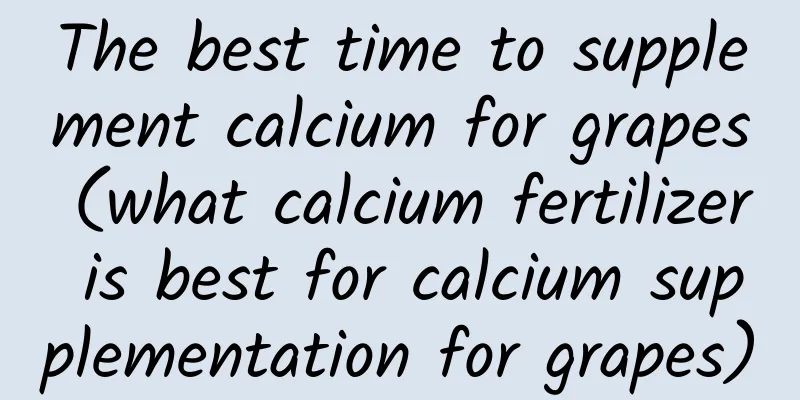The best time to supplement calcium for grapes (what calcium fertilizer is best for calcium supplementation for grapes)

|
In agricultural cultivation, calcium is a trace element used in relatively large quantities, second only to nitrogen, phosphorus and potassium. Therefore, some people call calcium the "fourth major element." In grape cultivation, calcium is also one of the more critical elements. It is related to the yield and quality of grapes, and its importance is self-evident. Calcium requirements of grapesCalcium is a nutrient that grapes require in relatively large quantities. In particular, many soils contain relatively low amounts of calcium, so artificial fertilization is needed to supplement the grapes' need for calcium. Generally speaking, producing 1,000 kg of grapes requires 6.7 kg of nitrogen, 7.5 kg of potassium, 4.0 kg of calcium and 2.1 kg of phosphorus. It can be said that grapes' demand for calcium is even greater than their demand for phosphorus. This shows the importance of calcium to grapes. The role of grapes in calcium supplementation1. Promote the transmission and absorption of nutrients, increase fruit enlargement and sweetness. 2. Increase the toughness of the fruit peel and reduce the occurrence of diseases such as fruit rot, fruit cracking, and sunburn. 3. Promote coloring, increase fruit powder, and improve the appearance of grape fruits. 4. Improve the stress resistance of grapes and reduce the occurrence of diseases and pests. When to supplement calcium for grapesCalcium supplementation for grapevines is a process throughout the entire growth period and can be specifically divided into three stages. From budding to fruiting The calcium demand during this period accounts for about 40% of the whole year, which is to lay a good foundation for the grapevine to bloom and fruit. From fruit setting to hard core stage The calcium applied at this time accounts for about 30% of the annual amount, mainly to promote the development of the fruit peel, resulting in thick leaves, developed root system, strong growth and strong disease resistance. From the hard core stage to the coloring stage This is the peak period for calcium supplementation for grapes. Although the time is short, the demand is relatively large. It is mainly to increase the yield. The skin can be thickened and the fruit cracking can be reduced; the fruit stalks can be thickened and the grains will not fall off; the leaves can be healthy and will not age prematurely. Grapes as a calcium supplementIncrease the use of organic fertilizer Organic fertilizer contains various nutrients and can improve soil conditions and regulate soil pH. Fertilizer flushing Flush application of trace elements is the simplest and most direct way. Combined with the application of organic fertilizer in autumn, apply 1 to 2 kg of calcium nitrate to each fruit tree. In March, before the first peak of root growth, apply 0.25 kg of superphosphate to each tree. Foliar spray In addition to flushing, calcium can be supplemented by foliar spraying in the early growth stage of grapes, the young fruit expansion period and one month before harvest. This method is faster and more effective. |
<<: Why do leeks grow thinner and thinner? (Why do leeks grown at home grow smaller and smaller?)
>>: What fertilizer is best for growing ginger (what organic fertilizer is best for growing ginger)
Recommend
When is the best time to sow mint?
Mint is not only a refreshing vegetable on the ta...
What to do if the leaves of Polygonatum odoratum turn yellow
The reason why the leaves of Polygonatum odoratum...
The role and value of white sandalwood
Medicinal value of white sandalwood Sandalwood ca...
How to care for newly bought Phalaenopsis
1. Lighting Phalaenopsis is a plant that likes li...
The efficacy and function of Jasper
1. The value of history In the earliest times, it...
Tips for carnation flower arrangement maintenance and preservation
Selection of carnation branches When choosing car...
How to repot a golden diamond
1. Time to change pots Because the growth rate of...
Yellowing of hyacinth leaves and treatment techniques
reason Water yellow Excessive watering causes yel...
The meaning of Milan
1. Its meaning Its implication is that with love,...
Don’t worry if the leaves of the green radish turn yellow. Just bury 2 or 3 soybeans in the soil and they will come back to life in a few days!
But recently, a flower lover came to tell Huahua ...
The role and use of diammonium phosphate (techniques and precautions for using diammonium phosphate)
Diammonium phosphate is called "king fertili...
Causes and treatments of yellow magnolia leaves
1. Excessive watering 1. Reason: Excessive wateri...
Do rose potted plants like water? Are they water-loving plants?
Do rose pot plants like water? Rose potted plants...
How long does it take for mint to grow in the basin?
Mint acclimatization time Mint is usually repotte...
How to care for the sedge in winter
Are you afraid of freezing when you are getting h...









